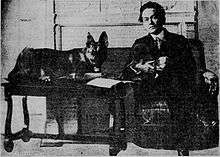Royal Dixon

Royal Dixon (25 March 1885? – 4 June 1962) was an American author, animal rights activist and a member of the Americanization movement.
Biography
Dixon was born at Huntsville, Texas, to Elijah and Francis Elizabeth Dixon. and educated at the Sam Houston Normal Institute, Morgan Park Academy, Chicago and later as a special student at the University of Chicago. His earliest career was as a child actor and dancer trained by Adele Fox. His last theatre appearance was in 1903 as an actor with the Iroquois theater in Chicago.[1] He became a curator at the department of botany at the Field Museum of Chicago from 1905 to 1910. He subsequently became a staff writer at the Houston Chronicle. He also made special contributions to the newspapers of New York, where he lectured for the Board of Education and founded a school for creative writing. His interest and attention were later directed to immigration, as a director of publicity of the Commission of Immigrants in America, and as managing editor of The Immigrants in America Review. He published a book on how immigrants needed to be "americanized" into a single uniform culture.[2] In 1921 he founded the First Church for Animal Rights in Manhattan and it had a membership of about 300 people. His aim was to "awaken the realization" that animals have "the inalienable right to life, liberty and the pursuit of happiness."[3][1] Dixon lived with his partner, a local artist, Chester Snowden. Dixon's letters and works are archived at the University of Houston Library.[4]
Publications
His published works include:
- The Human Side of Plants (1914)
- Signs is Signs (1915)
- Americanization (1916)
- Forest Friends (1916)
- The Human Side of Trees : wonders of the world (1917)
- The Human Side of Birds (1917)
- The Human Side of Animals (1918)
- Hidden Children (1922)
- (With Franklyn E. Fitch) Personality of Plants (1923)
- (With Brayton Eddy) Personality of Insects (1924)
- The Ape of Heaven (1936)
- Half Dark Moon (1939)
References
- 1 2 "Founder of the Animal Church explains all about it" (PDF). New York Tribune. 27 March 1921. p. 5.
- ↑ Williamson, C.C. (1919). "[Review] Americanization by Royal Dixon.". National Municipal Review. 8 (1): 72–73. doi:10.1002/ncr.4110080118.
- ↑ Mighetto, Lisa (1988). "Wildlife Protection and the New Humanitarianism". Environmental Review. 12 (1): 37–49. JSTOR 3984376.
- ↑ Barnes, Elizabeth. "Royal Dixon Manuscripts, 1914-1962.". University of Houston Libraries. Retrieved 12 February 2016.
External links
- Works by Royal Dixon at Project Gutenberg
- Works by or about Royal Dixon at Internet Archive
- Works by Royal Dixon at LibriVox (public domain audiobooks)
